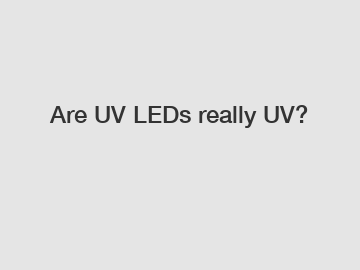Are UV LEDs really UV?
Are UV LEDs really UV?
Ultraviolet (UV) light is a type of electromagnetic radiation that lies beyond the visible spectrum of light, with wavelengths ranging from 10 nm to 400 nm. UV light is commonly used for sterilization, disinfection, and curing processes due to its ability to destroy harmful microorganisms and initiate chemical reactions. In recent years, UV light-emitting diodes (LEDs) have become increasingly popular for these applications. But are UV LEDs really UV?
Understanding UV Light and UV LEDs.

UV light can be classified into three categories based on their wavelength:
- UVA (long-wave UV): 315-400 nm.
- UVB (medium-wave UV): 280-315 nm.
- UVC (short-wave UV): 100-280 nm.
UVC light, with wavelengths between 100-280 nm, is the most effective for disinfection purposes as it can destroy the DNA and RNA of pathogens, rendering them unable to replicate. Traditional UVC lamps have been used for decades to sterilize air, water, and surfaces in hospitals, laboratories, and other critical environments.
UV LEDs are a newer technology that emits UV light when an electric current passes through a semiconducting material. UV LEDs are compact, energy-efficient, and have a longer lifespan compared to traditional UVC lamps. They are commonly used in portable sterilization devices, water purifiers, and UV curing systems.
Are UV LEDs Genuine UV?
While UV LEDs are marketed as producing UV light, there has been some confusion over whether they truly emit UV-C light. Many UV LEDs on the market fall into the UVA or UVB categories, with wavelengths above 280 nm. These LEDs may not be as effective at disinfection as true UVC LEDs due to their longer wavelengths.
To determine if a UV LED is producing genuine UVC light, it is essential to check the specific wavelength emitted by the diode. Genuine UVC LEDs emit light in the range of 260-280 nm, ensuring optimal disinfection capabilities. Consumers and businesses looking to use UV LEDs for sterilization purposes should verify the wavelength of the LED to ensure they are getting the desired germicidal effect.
Benefits and Limitations of UV LEDs.
UV LEDs offer several advantages over traditional UVC lamps, including:
- Energy efficiency: UV LEDs consume less power and have a longer lifespan.
- Compact size: UV LEDs can be miniaturized, making them suitable for portable and handheld devices.
- Instant on/off: UV LEDs do not require warm-up time and can be switched on and off instantly.
However, UV LEDs also have limitations:
- Limited range: Some UV LEDs may not emit light in the germicidal UVC range.
- Cost: Genuine UVC LEDs can be more expensive than UVA or UVB LEDs.
- Output intensity: UV LEDs may have lower output intensity compared to traditional UVC lamps.
Conclusion.
In conclusion, while UV LEDs are a promising technology for sterilization and disinfection applications, it is essential to ensure that they are emitting genuine UVC light for optimal germicidal effectiveness. Consumers should be aware of the specific wavelength emitted by the UV LED and choose a diode that falls within the UVC range for maximum disinfection capabilities.
If you have any questions about UV LEDs or need assistance in selecting the right UV LED for your application, please feel free to contact us.
The company is the world’s best smd led pcb, Uv Led Chip, cob led chip specs supplier. We are your one-stop shop for all needs. Our staff are highly-specialized and will help you find the product you need.


Comments